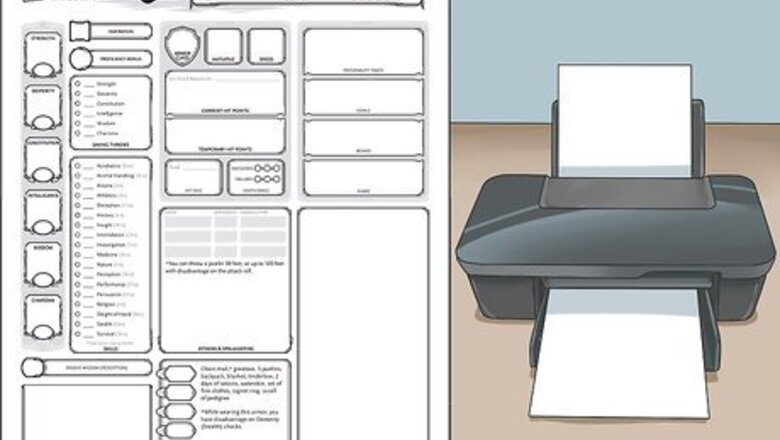
views
- Select your D&D character’s race and class to determine their natural strengths and weaknesses.
- Apply ability scores to boost your D&D character’s intelligence, strength, and charisma to aid you in your adventure.
- Equip your character with spells and/or weapons to improve your chances in battle and damage your enemies.
Choosing Your D&D Character’s Race and Class

Print a character sheet, if desired. Filling out a character sheet will lay out all the information you’ll need to create a character in an orderly fashion. Alternatively, write out your character information by hand on a blank sheet of paper, or type it up on a computer. Find free and example character sheets on the D&D Wizards of the Coast Website, or do a keyword search for “dungeons and dragons 5e character sheets” to find and print one of your own. Digital character sheets can help you keep track of your characters on devices like phones and tablets.

Select a gender and race. Once you’ve determined your character’s gender, choose a race (species) for your character. There are 9 basic races, though some players may allow other races to be used. Each race has certain unique characteristics, abilities, strengths, and weaknesses. The 7 basic races are: Dragonborn: Proud, self-sufficient, and loyal. Dragonborn are descended from dragons and possess attributes of both dragons and humanoids. Stat modifiers: +2 Strength, +1 Charisma Dwarves: Short, stocky, stern, and strong. They have a connection to the earth and often live in mountains or underground lands. Stat modifiers: +2 Constitution Elves: Tall, long-lived, aloof, and connected to nature. Elves live in harmony with the natural world around them. Stat modifiers: +2 Dexterity Gnomes: Mysterious, adventure-seeking, and strange. Gnomes are the smallest common race. Stat modifiers: +2 Intelligence Half-elves: Solitary, long-lived, graceful, and hearty. Half-elves are few in number, and tend to be wanderers due to their lack of homeland. +2 Charisma, +1 in 2 abilities of your choosing Half-orcs: Independent, strong, and distrusted. Half-orcs are considered monstrosities by common folk. They are tall and powerfully built. Stat modifiers: +2 Strength, +1 Constitution Halflings: Optimistic, cheerful, curious, and small in stature. Only 3 ft (.9 m) tall on average, they are agile but physically weak. Stat modifiers: +2 Dexterity Humans: Adaptive, ambitious, and well-balanced. Humans are the dominant race and are diverse in appearance and culture. Stat modifiers: +1 to each ability Tieflings: Stubborn, quick-tempered, and self-reliant. Tieflings are half-human, half-otherworldy being. Stat modifiers: +1 Intelligence, +2 Charisma
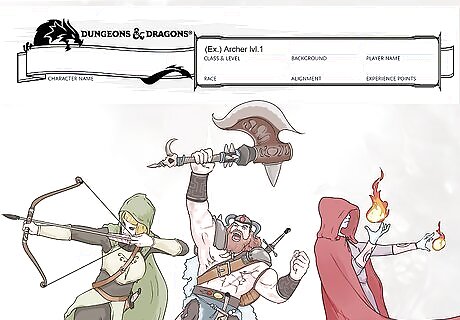
Choose a class. A character’s class is like their profession. If your character is starting from scratch at level one, you’ll also be level one in your class. As your character completes adventures, they’ll gain experience points (XP), which are used to raise your level and earn abilities and powers. There are 12 basic classes: Barbarian: Uncivilized and strong, barbarians are considered brutal berserkers. Bard: Charismatic and crafty, bards use skills and spells to help and harm. Cleric: Firm believers in a deity, clerics heal, raise the dead, and direct the wrath of god. Druid: At one with nature, druids cast spells, interact with animals, and shapeshift into animals and plants. Fighter: Firm and brave, fighters are capable with weapons and comfortable in armor. Monk: As martial masters, monks train their minds and bodies for offense and defense. Paladin: Followers of the good and just, paladins are devoted knights. Ranger: Masters of woodcraft and wildlife, rangers track and hunt foes. Rogue: Stealthy assassins, rogues are cunning thieves and able scouts. Sorcerer: Natural-born spellcasters, sorcerers command strange, ancient energies. Warlock: As people who gained magic from a bargain with an extraplanar entity, warlocks have fewer magic charges but regain them more easily. Wizard: As lifelong magic students, years of study allow wizards to use awesome magic powers.
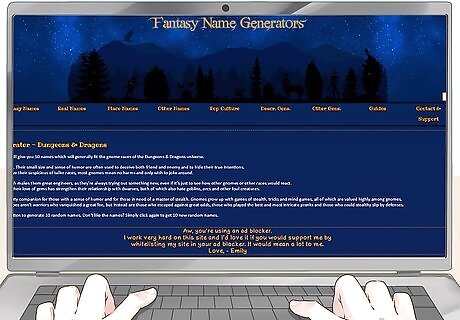
Name your character. Try choosing a name that represents your class, like Jafar for an evil wizard, for example. In classic D&D, different races have names that reflect their culture and native language. Find free name pools and generators online or by searching for your character’s race, like “gnome forgotten realms name generator” or “dungeons & dragons dwarf name pool.” Use name generators to get a feel for the kinds of names in your character’s race and come up with your own. Cycle through names with the generator until you find one that suits your character. Borrow names from your favorite video game, book, and comic characters, or even use the name of your favorite historical figure.
Calculating Your D&D Character’s Ability Scores
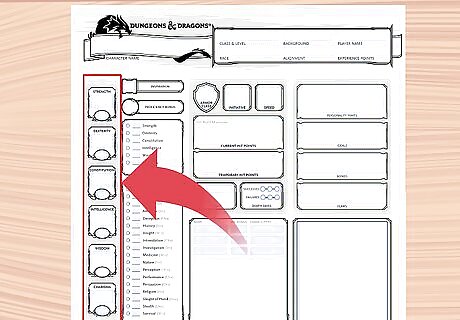
Identify the main attributes of your character. Every character is made up of 6 essential attributes. These are given scores, with high scores reflecting positive bonuses from that attribute and low scores penalties. A score of 10 in any attribute is considered average. The 6 attributes are: Strength (Str): A measure of physical power. Important for combat characters like fighters, monks, and paladins. Strength also dictates how much weight you can carry. Dexterity (Dex): A measure of agility. This includes balance and reflexes. Important for rogues, light- to medium-armor wearing characters, and ranged attackers (like bow and sling users). Constitution (Cons): A measure of health and fortitude. Constitution increases your character’s hit points, which, if depleted, can result in fainting or death. Intelligence (Int): A measure of knowledge. Important for wizards and classes requiring reason or learning, like paladins. Wisdom (Wis): A measure of correct judgment. Wisdom contributes to common sense, awareness, and willpower. Important for clerics, druids, and rangers. Charisma (Cha): A measure of magnetism. High charisma improves likability, appearance, and leadership ability. Important for bards, paladins, and sorcerers.
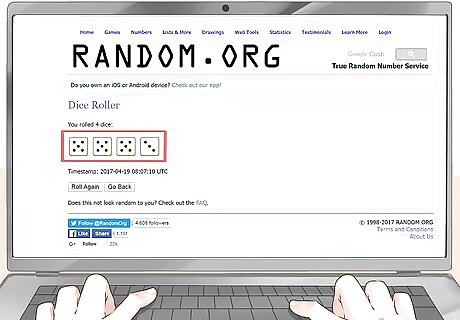
Roll for ability scores and assign them to the 6 main attributes. Use 4 six-sided dice (4d6) or an online dice roller. Roll all 4 dice, then add the 3 highest dice together and record the number. Repeat this until you have 6 recorded numbers, then assign them to your attributes, remembering to add your racial stat modifiers to your total scores. Use fewer dice when rolling ability scores to increase the difficulty of your D&D experience. 3d6 is often called “classic,” and only using 2d6 is termed “heroic.” To provide an example of a racial stat bonus: after rolling your ability scores, if you were a human, you’d get +2 points for any one attribute. If you don’t want to roll for your abilities, find and use an online generator by doing a keyword search for “ability score generator.”
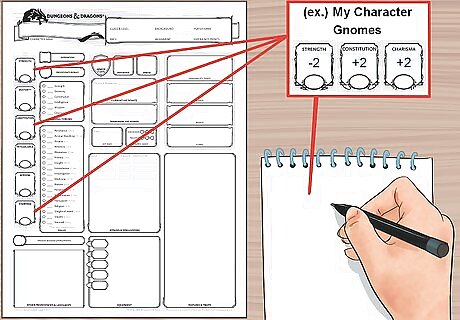
Record the modifier for each ability. The ability modifier is the bonus or penalty each ability score gives your character. For example, an ability score of 10 or 11 is average, so it has no bonuses or penalties (+0). Modifier bonuses or penalties are added or subtracted to any activity requiring one of these main attributes. Modifiers can also grant additional spells per day in an ability, if applicable. The following list provides some ability scores followed by their modifiers: Score / Modifier 1 / -5 2 – 3 / -4 4 – 5 / -3 6 – 7 / -2 8 – 9 / -1 10 – 11 / +0 12 – 13 / +1 14 – 15 / +2 16 – 17 / +3 18 – 19 / +4 20 – 21 / +5 22 – 23 / +6 24 – 25 / +7 26 – 27 / +8 28 – 29 / +9 30 / +10
Equipping Your D&D Character’s Skills, Weapons, and Armor
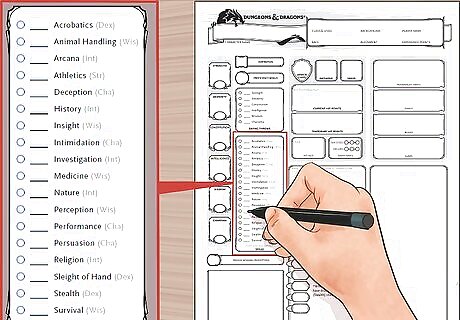
Select skills for your character. Skills are important basic abilities. Character sheets provide an extensive list of these, including Acrobatics, Climb, Knowledge (history), Linguistics, Stealth, and more. Earn skills by gaining levels and accumulating XP. With each new level, your character gets skill ranks which are invested into specific skills, like Bluff, Sleight of Hand, or Swim. Characters with higher intelligence receive more skill points for investing in skill ranks. Your rank in a skill cannot be higher than the combined total of your character level and 3.
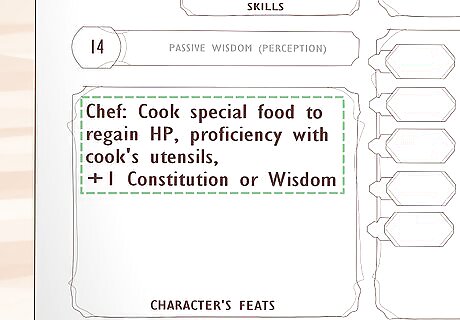
List your character’s feats (optional). Feats represent talents or abilities (not linked to race or class) that improve class abilities and lessen class penalties. When using the optional feats rule, opt out of improving an ability score when you level up in favor of choosing a feat. You can only take each feat once unless its description says otherwise. Some feats have restrictions, like a minimum ability score or level. Here are some feat options: Actor: mimic the speech or sounds of a person or creature, advantage on Deception and Performance checks, +1 Charisma Chef: cook special food to regain HP, proficiency with cook’s utensils, +1 Constitution or Wisdom Fey Touched: learn “Misty Step” and 1 first-level spell from divination or enchantment school, +1 Intelligence, Wisdom, or Charisma Great Weapon Master: perform an extra attack after a melee critical hit, choose to take -5 to attack roll to add +10 damage to an attack with a heavy weapon Keen Mind: always know which way is north, when the next sunrise/sunset is, and recall any events within the past month. +1 Intelligence Linguist: learn 3 languages and create ciphers, +1 Intelligence Lucky: reroll 1 d20 or reroll an attack roll against you Observant: read lips, +5 bonus in Perception and passive Investigation, +1 Intelligence or Wisdom Savage Attacker: reroll melee weapon attack damage once per turn Skilled: gain proficiency with 3 skills or tools

Roll for your starting gold. Gold (GP), which is the currency of D&D, is usually awarded for completing quests and defeating enemies. However, each character starts with a pre-determined amount. This amount depends on your character’s class. Determine your starting GP by rolling 4-sided dice and calculating: Barbarian: 2d4 x 10 GP Bard: 5d4 x 10 GP Cleric: 5d4 x 10 GP Druid: 2d4 x 10 GP Fighter: 5d4 x 10 GP Monk: 5d4 (no x 10 GP) Paladin: 5d4 x 10 GP Ranger: 5d4 x 10 GP Rogue: 4d4 x 10 GP Sorcerer: 3d4 x 10 GP Warlock: 4d4 x 10 GP Wizard: 4d4 x 10 GP
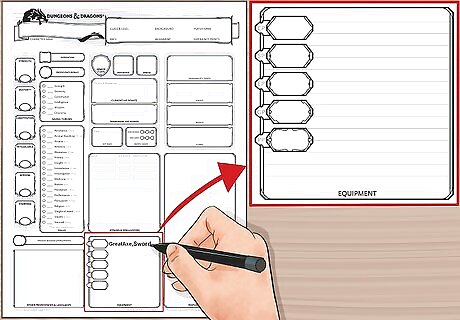
Equip your character with items. Choose equipment best suited for your character’s class and race. Use gold to buy the starting weapons, armor, items, and equipment for your character. In some games, you may only have simple weapons or armor available until you find a suitable shop where you can buy better ones. Common weapons include daggers, spears, crossbows, battleaxes, longswords, and war hammers. Some common types of armor include hide armor, breastplates, chain mail, and plates. Some items and equipment include potions, torches, food, various tools, tents, and rope. Characters that are suited for the center of the action, like fighters and paladins, will likely need heavy armor like plate mail and a shield, along with a weapon like a broadsword or mace. Characters that are agility-based, like gnomes, rogues, and rangers, are better suited to light armor, like chainmail or boiled leather, and distance or sneak attack weapons like a bow, sling, or a Kukri knife. Frail characters, like many wizards and bards, may only be able to equip very light armor or robes. Weapons, too, are usually limited to light varieties, like rods, staves, bows, and whips.
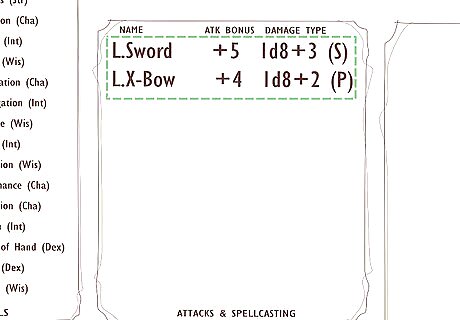
Fill up spell slots (optional). If your character uses magic, you can equip spells to use as attacks and defense methods. Learn new spells as you level up. Find details and specific spell information in your player’s handbook. Some classes, like bards and sorcerers, have a limited list of spells memorized. Other classes, like clerics and wizards, must prepare spells before using them. The number of spell slots you have depends on your level. You gain more slots as you level up. In your handbook, each spellcasting class’s description includes a table showing how many spell slots they have. Resting for a long period of time restores expended spell slots. Sometimes scrolls you find in your adventure contain spells that you can copy into your spellbook. Some useful spells include Fireball, Comprehend Languages, Purify Food and Drink, Shield, and Spare the Dying.
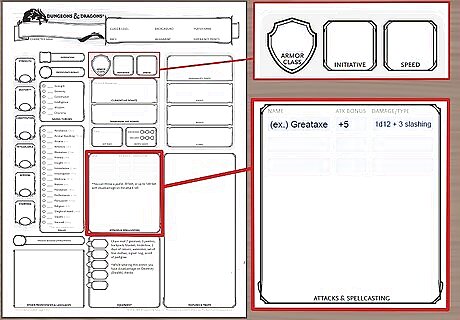
Fill in armor class and combat bonuses. Weapon and armor bonuses will be listed along with the weapon and armor information. In some cases, like with very heavy weapons and armor, there may also be penalties. A high armor class (AC) will make your character more resistant to damage. Attack bonuses help you land damaging hits. Use the following calculations to determine your AC and attack bonuses: AC = 10 + armor bonus + shield bonus + Dexterity Modifier + other modifiers (like racial or class) Melee attack bonus = base attack bonus + Strength Modifier + size modifier Ranged attack bonus = base attack bonus + Dexterity Modifier + size modifier + range penalty (if any) Size modifiers are determined according to the following scale: Colossal (-8), Gargantuan (-4), Huge (-2), Large (-1), Medium (+0), Small (+1), Tiny (+2), Diminutive (+4), Fine (+8). Small characters are generally more agile, whereas large ones are generally strong. Larger characters can also carry larger and heavier objects.
Calculating Your D&D Character’s Hit Points

Calculate hit points to determine how much damage you take. Use your hit point dice to determine your hit points. When starting out, your hit points equal the highest roll of your hit point dice + your Constitution modifier. As you level up, so do your hit points. Here are the hit point dice for each class: Barbarian: d12 Bard: d8 Cleric: d8 Druid: d8 Fighter: d10 Monk: d8 Ranger: d10 Rogue: d8 Paladin: d10 Sorcerer: d6 Warlock: d8 Wizard: d6 Record your hit points and the type and amount of hit point dice you have. When your character rests in-game, you can spend hit point dice to regain hit points. Dropping to 0 HP either kills you or knocks you unconscious. If damage remains after you hit 0 HP, you die if the remaining number is equal to or higher than your max HP.
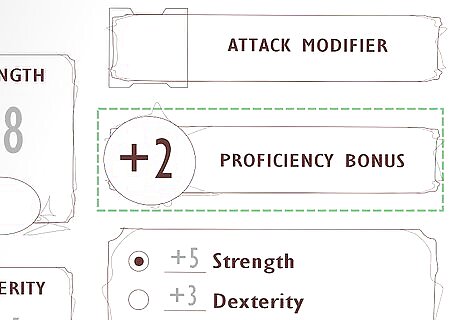
Add your proficiency modifier. Proficiency modifiers are bonuses you add to any checks made with a skill or weapon you’re proficient with. All characters begin with a +2 proficiency modifier at level 1, and it increases with each level at a rate dependent on your class.
Calculating Your D&D Character’s Attacks
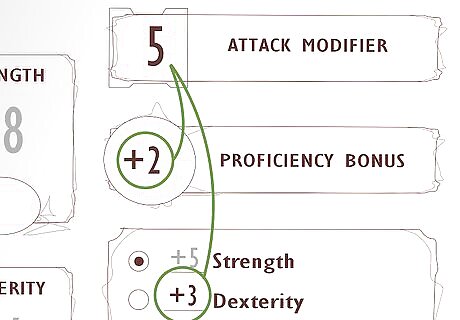
Calculate your attack modifier. When attacking an enemy, add an attack modifier to a d20 roll. If the final number is equal to or higher than your enemy’s Armor Class (AC), your attack is successful. Your attack modifier depends on your weapon and your proficiency with it. Here’s how to calculate it: For ranged weapons you’re proficient with, add your proficiency modifier to your Dexterity modifier. If you aren’t proficient, use only your Dexterity modifier. For melee weapons you’re proficient with, add your proficiency modifier to your Strength modifier. If you aren’t proficient, use only your Strength modifier. If the weapon has Finesse, you’ll do the same process, but you can choose whether to use Strength or Dexterity.
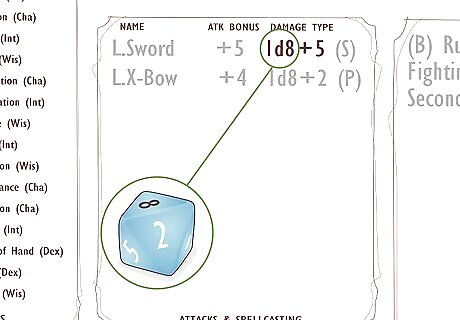
Determine the amount of damage done. Each weapon, spell, or ability specifies the amount of damage it deals, so check your handbook for whichever weapon you use. Roll the die or dice specified, then add any modifiers and apply the total number to your enemy’s damage. With penalties, it is possible to roll 0 damage but never negative damage. When using a weapon, add your ability modifier to the damage. Using a spell will tell you which dice to roll and whether to add a modifier.
Choosing Your D&D Character’s Moral Alignment & Personality
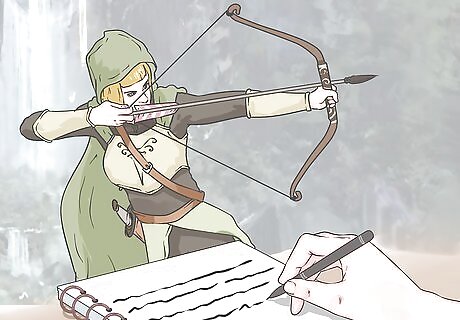
Describe your character’s looks and personality. Write down the description, or if you’re artsy, draw or sketch your character. Include basic physical features like age, weight, height, skin color, etc. Think of your character’s personality, which will influence the decisions they make in the game. Write a backstory for your character. What was their childhood like? How did they end up where they are today? This will give you a better sense of the character as separate from yourself, which will help with roleplaying later. Determine goals, fears, and desires to add depth to your character. Keep these in mind as you play your character and interact with other players and non-player characters (NPCs).
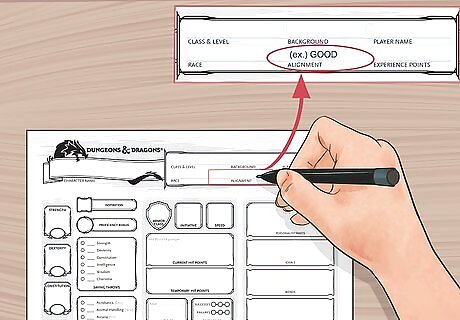
Determine the alignment of your character. Alignment is a measure of moral attitude. There are nine basic alignments that encompass a range of personalities, philosophies, and beliefs. Alignment consists of one order characteristic (Lawful, Neutral, Chaotic) and one moral characteristic (Good, Neutral, Evil), as in lawful-neutral, lawful-evil, neutral-good, and chaotic-good. Good characters are driven to protect innocence and life. Good sacrifices for others and cares for the dignity of sentient creatures. Evil characters undermine or harm life. Evil hurts, harms, and oppresses, usually for fun or personal gain. Morally neutral characters avoid killing, but usually lack a sense of obligation to sacrifice for or protect others. Lawful characters respect order, truth, authority, and tradition. They are often closed-minded, overly rigid, and self-righteous. Chaotic characters make decisions according to their conscience. They resent authority and love freedom, though they can be reckless and irresponsible. Order neutral characters are generally honest but susceptible to temptation. They feel neither a need to obey orders nor rebel.
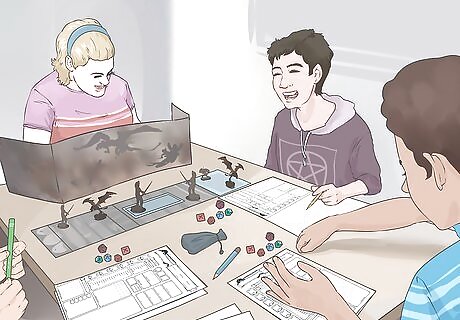
Play your character in a campaign. Join other players so you can play your character in a campaign decided or created by your dungeon master. Sample campaigns and resources can be found online, but so long as you have access to a core rulebook, you can create your own D&D world. For those who are brand new to D&D, Dungeon Masters (DMs) are the coordinators of the game. They describe the setting, control non-player characters, and design campaigns for characters to overcome.


















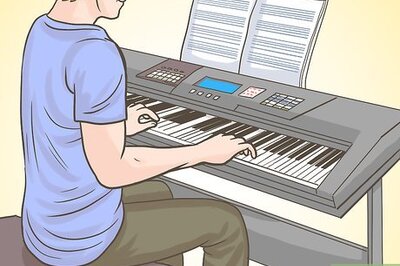
Comments
0 comment